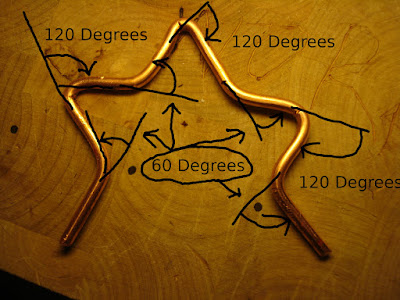That's right, this little baby picks up 23 digital channels (fox has a 24 hour weather channel too.) I think the best part is that almost every channel is high definition, and even though they pushed back the conversion to digital to June, I am much happier with Digital than I ever was with an antenna.
Anyway, I want to get into a little bit about how I made my antenna.
For this duct-tape beauty, I actually went to the store and bought some wire. That's right, this one isn't just peiced together with junk that I found around the house, or that people just gave to me for free.
I spent a whole $3!
All you need, is to go to your local hardware store and buy 28 inches of 6 gauge copper wire, and you might want to go to an electronics store and buy a TV-matching transformer. The rest you can peice together from whatever you want. it all depends on if you care about the way the thing works.
However, there is one important rule to follow... don't connect to two sides together with a piece of metal. It won't hurt anything, but your reception will go down the tube.
So anyway... back to the instructions.
Here is a breif breakdown of how to make this antenna:
- Get your materials
- 32 inches of 6 gauge copper wire
- you may want extra in case you make a mistake, get extra wire in 8 inch increments, each increment will allow for 1 mistake
- The directions that originally inspired me to make this said for 18 gauge... I disagreed!
- a TV (Impedance Matching) Transformer
- I am told that you want 300 - 50 ohms
- duct tape and electrical tape
- (although some people say to use screws with washers)
- A this piece of plastic about 4 X 8 inches in size
- I broke one of those magnetic picture things that you get from the dollar store.
- it wasn't one of the ones my sister got me...
- Needle nose vice grips (I suppose you could probably use pliers)
- You may want two pairs, but I made do with what I had
- A good pair of wire cutters
- or just ask the person at the hardware store to cut 6 - 8" strips
- An 8 inch ruler
- I used a carpenter's square
- A protractor
- Yet again the carpenter's square and a piece of paper...
- A marker
- Make your fractals
- Cut an 8" piece of wire
- Measure out and mark 1 inch increments in the copper
- you may want to make a notch in the copper because the marker can rub off
- Draw a straight line on a piece of paper, then use the protractor (or carpenter's square) to find a 60 degree angle, and draw a second line that passes through the first line at 60 degrees.
- You now have a 60 degree angle, and a 120 degree angle on the paper
- bend the wire at each inch marker using this patter:
- bend the wire 60 degrees to the left
- Then bend the wire 120 degrees to the right
- repeat steps one 1 and 2 two more times
- then bend the wire 60 degrees to the left
- Now do this 3 more times so you have 4 fractals.
- Make your dipoles (After all, this is a type of dipole antenna)
- For this, you need to take 2 straight pieces of 6" to 8 " wire
- I really don't know yet if it helps to use larger pieces of wire.
- use electrical tape to fasten one fractal to the end of each wire
- The picture best illustrates how this looks
- Mount the dipoles and the transformer
- Layout your piece of plastic, and draw a few lines on it so that the antenna looks symetrical.
- There probably is more science to what works best, but if you use duct tape, then you can experiment on your own...
- Connect one wire from the transformer to each dipole, and there you have it!
I would also like to take this opportunity to note that the location of your antenna is very important. I have a 25 foot coax cable so I could move my antenna to the perfect spot. As you can see here:
I had to go all over the apartment before I found the "majic" spot where the antenna picks up all the channels and a spot where I could actually mount an antenna; I had done similar chores with all of my other anntenna's, but I just increased my cable length, and it was worth the extra couple of bucks to get a long coax cable.
So I plan to not mess around too much with my antenna situation for a few days... and maybe I'll actually watch a little of the TV I've worked so hard to get reception for... or maybe I'll just watch all the shows I've missed on Hulu.
but the important part is that now I have a choice between watching the shows whenever I want starting the day after they are aired on TV, or watching the shows at the mercy of the network exectutives!
Next time: After you get your antenna, you need to actually fine tune your stations...I'll talk about my battle to get Fox, and how I finally got it done.







No comments:
Post a Comment